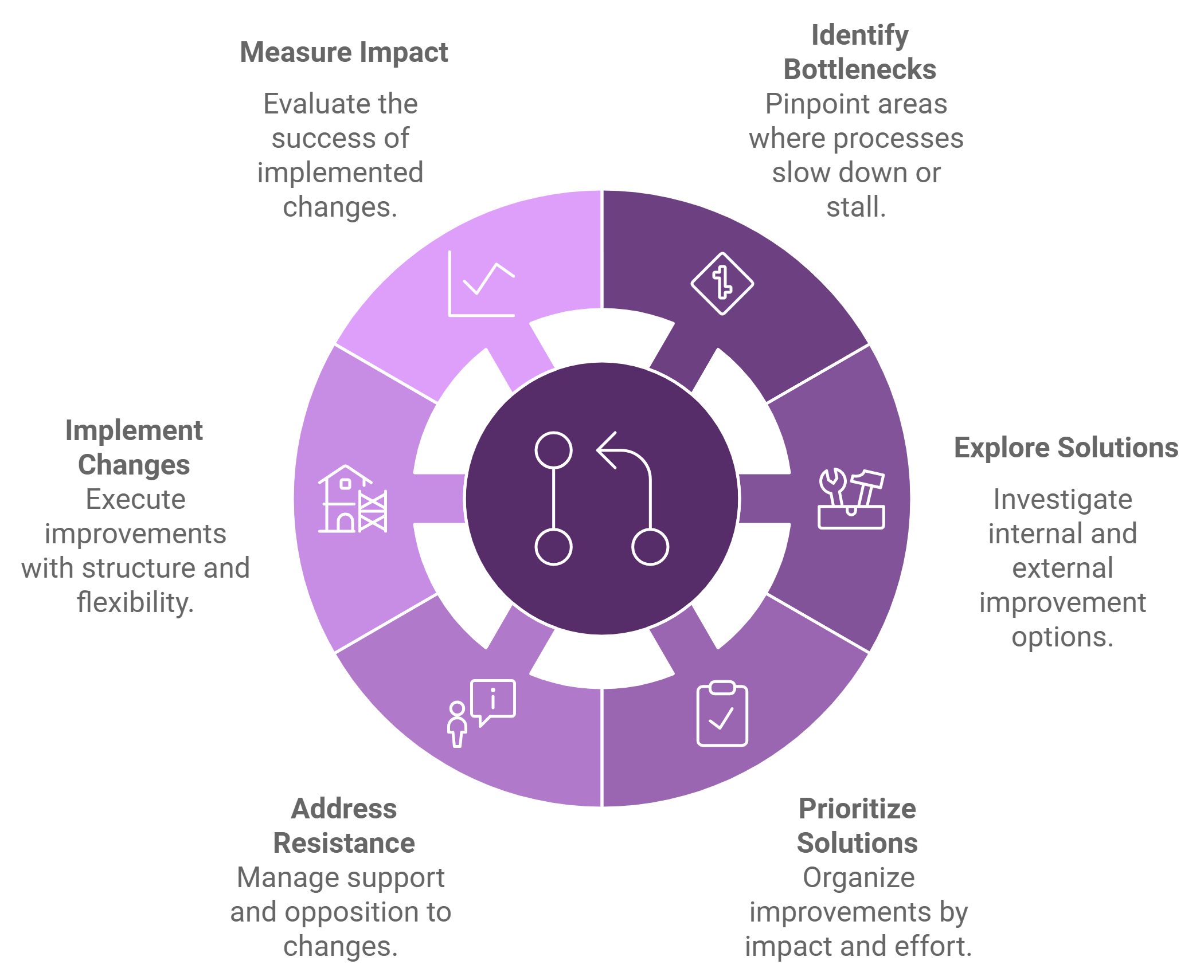In today’s fast-paced business world, many companies are seeking to improve processes and become more agile, yet few understand how to innovate effectively and sustainably. Innovation doesn’t necessarily require massive technology changes. It starts with a clear understanding of workflows, bottlenecks, and areas where even small adjustments can make a big impact.
Why is change so challenging? Many companies struggle to innovate without disrupting internal processes or confusing employees. This guide will walk you through a series of steps designed to help manage and implement change in a conscious, organized way.
Preparation: Understand Before You Change
Before diving into changes, it’s essential to know the structure you’re working with:
- Mapping Processes: Start by analyzing existing workflows and documenting each phase, including key decision points. This helps to clarify the structure and ensures no critical details are overlooked.
- Engage Diverse Perspectives: Involve team members from different roles to validate assumptions. Each person’s insights can offer a comprehensive view of what works and what doesn’t.
- Identifying Key Flows and Critical Points: Look for essential tasks that only one person fully understands—these are often “invisible” steps crucial to operations. An example of this is when someone needs to analyze a document, yet the criteria utilized are only known to that person.
A thorough preparation phase sets the foundation for targeted, effective innovation.
Analyzing Flows and Identifying Bottlenecks
With your processes mapped out, it’s time to identify areas for improvement.
- Finding Bottlenecks: Review workflows to detect points where information or tasks get delayed. These bottlenecks may be due to repetitive manual steps or inefficient task handoffs.
- Frequent Errors: Identify recurring issues that could be resolved with automation, training, or workflow redesign. Common examples include repetitive manual errors or time-consuming data entry tasks.
These insights help pinpoint where change can have the most impact.
Internal and External Analysis: Comprehensive Diagnosis
Once internal insights are collected, it’s time to assess external solutions.
- Internal Study: Interview key employees to understand their challenges and improvement ideas. Often, those closest to the process know where improvements could be made.
- External Research: Explore the market for tools or technology solutions that could streamline internal workflows. It’s possible the right tool is already available and can be adapted to meet your needs.
- Adaptation vs. Replacement: Change doesn’t always mean implementing new technology. Sometimes, adjusting existing processes yields the best improvements with less disruption.
This step helps to avoid reinventing the wheel and ensures that you’re looking at a range of options before committing to a plan.
Technology as a Means, Not an End
A key to conscious innovation is recognizing that technology is not the goal—it’s a tool.
Technology is a facilitator: Think of technology as a way to achieve specific goals rather than as the end goal itself. The focus should be on the additional value that technology can bring to already optimized processes, rather than on implementing tech for its own sake.
Consider cases where technology has enhanced a process rather than being the main change. For instance, a communication platform might improve team collaboration, but the real change lies in the team’s approach to managing projects, not in the tool itself.
This approach helps teams make grounded, thoughtful decisions about how and when to use technology.
Solution Prioritization: Identifying Value and Effort
Once you’ve identified potential improvements, it’s essential to prioritize them effectively.
- Organizing Priorities: Not every improvement will have the same impact. Organize solutions using frameworks to clarify where to focus efforts:
- Customer Value vs. Internal Value: Distinguish between improvements that benefit clients and those that streamline internal operations.
- Impact vs. Effort: Use tools like the Impact-Effort Matrix to prioritize solutions that provide maximum value with minimal effort. Quick wins can build momentum.
- Urgency and Importance: The Eisenhower Matrix (urgent vs. important) is useful for staying on top of essential business tasks without getting bogged down in less impactful ideas.
- Empathy Mapping: During the interview process, tools like empathy maps are invaluable for understanding how employees feel, think, and what they need during their workflows. This reveals potential obstacles and ideas for improvement, enhancing the solution design phase.
Building Support: Identifying Allies and Opponents
A vital part of any change process is knowing who will support your initiative and who may resist. Mapping Key Players:
- Allies: Supporters who understand and back the change. Empowering them as project “champions” can help build momentum.
- Opponents: Those who may resist change. Listening to their concerns can provide insight and help refine your approach.
- Neutral Parties: Those not directly affected but whose support could be helpful. Providing context and keeping them informed can align them with the goals of the project.
Building strong relationships with your allies and listening to opponents can create a smoother path for change.
Implementing Changes: Methodologies and Awareness
When it’s time to implement, structured methodologies and consistent communication make a significant difference. Here are just some implementation methodologies:
- ADKAR Model (Awareness, Desire, Knowledge, Ability, Reinforcement): This model encourages awareness of the change, the desire to participate, knowledge of implementation, ability to apply it, and reinforcement to maintain it.
- Agile Change Management: Iterative approaches allow changes to be implemented in stages, adjusting and optimizing based on real-time results. Teams see tangible benefits quickly, easing adaptation and fostering a culture of continuous learning.
- Awareness and Continuous Communication: Though not a methodology, per se, it´s crucial to communicate the benefits of the change to everyone involved, showing how it will impact their roles and improve the product. Transparency and regular updates reduce uncertainty and gain active participation.
Measuring and Continuous Feedback
No change process is complete without measurement and feedback.
- Measuring Results: Each implemented change should include clear metrics for success, such as Key Performance Indicators (KPIs) specific to the process or area, to verify impact and make adjustments as needed.
- Feedback Cycle: Gather input from those using the improved process to see how well it meets their needs. Surveys, follow-up meetings, and feedback sessions can reveal insights.
- Iteration and Adjustment: Often, changes require fine-tuning. An iterative approach allows you to make continuous improvements and identify new opportunities as they arise.

Conclusion: Innovate with Purpose and Preparation
Innovating within a company requires preparation, analysis, and, above all, empathy with everyone involved. Innovation isn’t just about implementing technology or making changes for the sake of change. It’s about optimizing processes to deliver value to both employees and clients Practical Next Steps:
- Continue building your skills in project management, change management, and agile methodologies. These are essential for implementing and sustaining effective improvements.
- Explore innovation tools and agile frameworks that can be tailored to meet your team’s needs.
If your company is ready to innovate but needs expert guidance and customized solutions, SutilMind is here to help. Our team of specialists can assist at every step, from planning to implementation and change management. Contact us to see how we can collaborate and take your company’s innovation to the next level.
